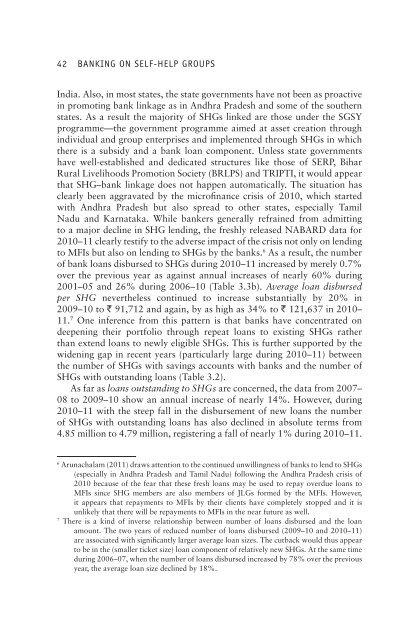Banking on SHGs - Nabard
Banking on SHGs - Nabard
Banking on SHGs - Nabard
- No tags were found...
You also want an ePaper? Increase the reach of your titles
YUMPU automatically turns print PDFs into web optimized ePapers that Google loves.
42 <str<strong>on</strong>g>Banking</str<strong>on</strong>g> <strong>on</strong> Self-Help GroupsIndia. Also, in most states, the state governments have not been as proactivein promoting bank linkage as in Andhra Pradesh and some of the southernstates. As a result the majority of <strong>SHGs</strong> linked are those under the SGSYprogramme—the government programme aimed at asset creati<strong>on</strong> throughindividual and group enterprises and implemented through <strong>SHGs</strong> in whichthere is a subsidy and a bank loan comp<strong>on</strong>ent. Unless state governmentshave well-established and dedicated structures like those of SERP, BiharRural Livelihoods Promoti<strong>on</strong> Society (BRLPS) and TRIPTI, it would appearthat SHG–bank linkage does not happen automatically. The situati<strong>on</strong> hasclearly been aggravated by the microfinance crisis of 2010, which startedwith Andhra Pradesh but also spread to other states, especially TamilNadu and Karnataka. While bankers generally refrained from admittingto a major decline in SHG lending, the freshly released NABARD data for2010–11 clearly testify to the adverse impact of the crisis not <strong>on</strong>ly <strong>on</strong> lendingto MFIs but also <strong>on</strong> lending to <strong>SHGs</strong> by the banks. 6 As a result, the numberof bank loans disbursed to <strong>SHGs</strong> during 2010–11 increased by merely 0.7%over the previous year as against annual increases of nearly 60% during2001–05 and 26% during 2006–10 (Table 3.3b). Average loan disbursedper SHG nevertheless c<strong>on</strong>tinued to increase substantially by 20% in2009–10 to ` 91,712 and again, by as high as 34% to ` 121,637 in 2010–11. 7 One inference from this pattern is that banks have c<strong>on</strong>centrated <strong>on</strong>deepening their portfolio through repeat loans to existing <strong>SHGs</strong> ratherthan extend loans to newly eligible <strong>SHGs</strong>. This is further supported by thewidening gap in recent years (particularly large during 2010–11) betweenthe number of <strong>SHGs</strong> with savings accounts with banks and the number of<strong>SHGs</strong> with outstanding loans (Table 3.2).As far as loans outstanding to <strong>SHGs</strong> are c<strong>on</strong>cerned, the data from 2007–08 to 2009–10 show an annual increase of nearly 14%. However, during2010–11 with the steep fall in the disbursement of new loans the numberof <strong>SHGs</strong> with outstanding loans has also declined in absolute terms from4.85 milli<strong>on</strong> to 4.79 milli<strong>on</strong>, registering a fall of nearly 1% during 2010–11.6Arunachalam (2011) draws attenti<strong>on</strong> to the c<strong>on</strong>tinued unwillingness of banks to lend to <strong>SHGs</strong>(especially in Andhra Pradesh and Tamil Nadu) following the Andhra Pradesh crisis of2010 because of the fear that these fresh loans may be used to repay overdue loans toMFIs since SHG members are also members of JLGs formed by the MFIs. However,it appears that repayments to MFIs by their clients have completely stopped and it isunlikely that there will be repayments to MFIs in the near future as well.7There is a kind of inverse relati<strong>on</strong>ship between number of loans disbursed and the loanamount. The two years of reduced number of loans disbursed (2009–10 and 2010–11)are associated with significantly larger average loan sizes. The cutback would thus appearto be in the (smaller ticket size) loan comp<strong>on</strong>ent of relatively new <strong>SHGs</strong>. At the same timeduring 2006–07, when the number of loans disbursed increased by 78% over the previousyear, the average loan size declined by 18%.














